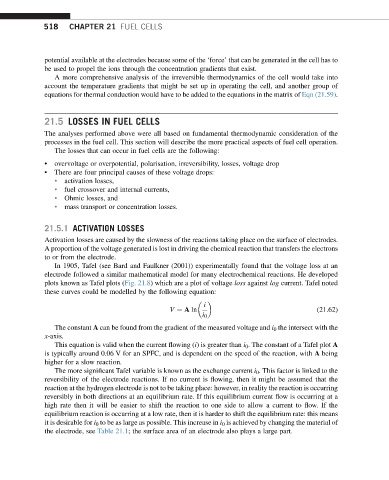Page 525 - Advanced thermodynamics for engineers
P. 525
518 CHAPTER 21 FUEL CELLS
potential available at the electrodes because some of the ‘force’ that can be generated in the cell has to
be used to propel the ions through the concentration gradients that exist.
A more comprehensive analysis of the irreversible thermodynamics of the cell would take into
account the temperature gradients that might be set up in operating the cell, and another group of
equations for thermal conduction would have to be added to the equations in the matrix of Eqn (21.59).
21.5 LOSSES IN FUEL CELLS
The analyses performed above were all based on fundamental thermodynamic consideration of the
processes in the fuel cell. This section will describe the more practical aspects of fuel cell operation.
The losses that can occur in fuel cells are the following:
• overvoltage or overpotential, polarisation, irreversibility, losses, voltage drop
• There are four principal causes of these voltage drops:
• activation losses,
• fuel crossover and internal currents,
• Ohmic losses, and
• mass transport or concentration losses.
21.5.1 ACTIVATION LOSSES
Activation losses are caused by the slowness of the reactions taking place on the surface of electrodes.
A proportion of the voltage generated is lost in driving the chemical reaction that transfers the electrons
to or from the electrode.
In 1905, Tafel (see Bard and Faulkner (2001)) experimentally found that the voltage loss at an
electrode followed a similar mathematical model for many electrochemical reactions. He developed
plots known as Tafel plots (Fig. 21.8) which are a plot of voltage loss against log current. Tafel noted
these curves could be modelled by the following equation:
i
V ¼ A ln (21.62)
i 0
The constant A can be found from the gradient of the measured voltage and i 0 the intersect with the
x-axis.
This equation is valid when the current flowing (i) is greater than i 0 . The constant of a Tafel plot A
is typically around 0.06 V for an SPFC, and is dependent on the speed of the reaction, with A being
higher for a slow reaction.
The more significant Tafel variable is known as the exchange current i 0 . This factor is linked to the
reversibility of the electrode reactions. If no current is flowing, then it might be assumed that the
reaction at the hydrogen electrode is not to be taking place: however, in reality the reaction is occurring
reversibly in both directions at an equilibrium rate. If this equilibrium current flow is occurring at a
high rate then it will be easier to shift the reaction to one side to allow a current to flow. If the
equilibrium reaction is occurring at a low rate, then it is harder to shift the equilibrium rate: this means
it is desirable for i 0 to be as large as possible. This increase in i 0 is achieved by changing the material of
the electrode, see Table 21.1; the surface area of an electrode also plays a large part.

